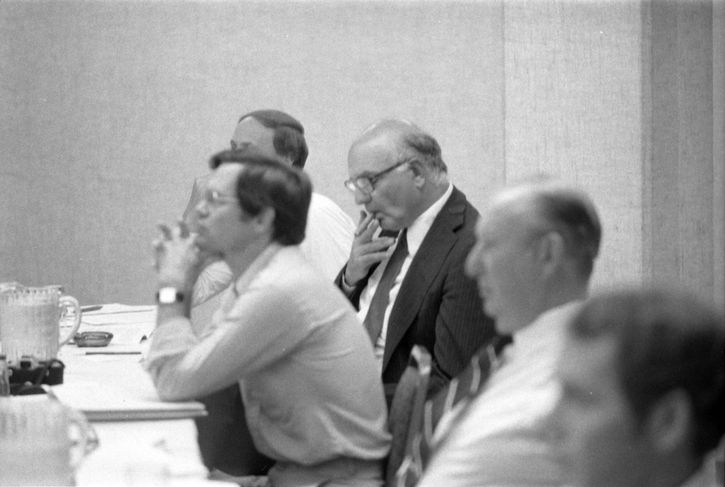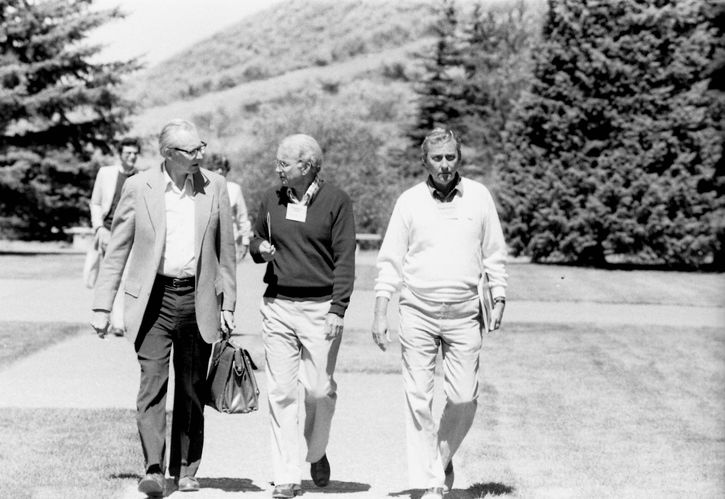A dinner conversation at the first symposium hosted by the Federal Reserve Bank of Kansas City was a precursor of things to come.
Sort of.
A Kansas City Fed economist was engaged in a discussion about supply and demand with a group that included policymakers from New Zealand and Australia and another prominent U.S. economist. There are, however, a couple of differences between this 1978 conversation, and innumerable others that have occurred over the years at the Kansas City Fed’s annual Economic Policy Symposium:
- Rather than occurring in late August at what is now the Symposium’s traditional site in Jackson Hole, Wyoming, this was a May conversation in a ballroom at Kansas City’s Crown Center.
- The discussion focused not on monetary policy, but on food—specifically U.S. policies that critics said were discouraging food production despite growing global demand. The discussion, although not officially on the Symposium agenda, aligned with the event’s theme: “World Agricultural Trade: The Potential for Growth.”
While the Kansas City Fed has gone on over the years to host numerous agricultural conferences—as well as others focused on energy, banking, community development and other issues—the Economic Policy Symposium has its roots firmly planted in a handful of agricultural conferences beginning in the spring of 1978.

Federal Reserve Chairman Paul Volcker (center) and other attendees were photographed during 1982 Symposium proceedings. Bank archives
Building slowly
At the time, the Bank was taking some early steps on a path to building its reputation for research expertise. Agriculture was an appropriate starting point for a Reserve Bank serving the Tenth Federal Reserve District—a seven-state region spanning the nation’s central plains and reaching the mountain west.
“In assessing our staff at the time, our strongest suit was in the regional area,” Kansas City Fed Research Director Tom Davis later said. “We focused on regional economics. We had a financial section and we had some very good people…but our strongest suit was in the region.”
His goal, however, was to create an event where discussion focused on matters more directly connected to the Fed’s role in guiding the nation’s monetary policy. Among the challenges of launching such an event was the need for experience in hosting large events with an international component, as well as attracting an audience of leading economists—many of whom were based in cities like Boston and Chicago, in addition to public officials in Washington, D.C.—at a time when business travel was relatively more costly and perhaps a bit less common than is the case today.
Thus, the Bank engaged in what its head of Public Affairs at the time, Barry Robinson, later said was “baby step evolution from a regional conference. We built the Bank’s name slowly.”
After four Symposiums with agricultural themes that were held in Kansas City as well as Vail and Denver in Colorado, the Bank transitioned the event themes as well as its location—settling at the foot of the Grand Tetons in 1982. The location, however, was not immediately clear to Bank leaders.
Robinson, whose staff played a critical part in event planning and logistics—roles that that the Bank’s Public Affairs staff continues to fulfill today—said that multiple locations were considered as Symposium hosts, including venues in Colorado and New Mexico.
At the time, it was widely known that Fed Chairman Paul Volcker was fond of fly fishing. Davis, who led the Symposium program, believed it was vital to the event’s success to have Volcker attend. In hopes of luring the chairman, Davis reached out to a contact in Colorado, trying for help identifying a location with good trout fishing around the event’s August date.
“He said, ‘Well, if you’re going to hold it in August, you can’t fish for trout in Colorado—it’s too warm. You need to go someplace north,’” Davis later recalled.
“I said, ‘Well, what do you mean? We’re confined in our District to Wyoming.’
“He said, ‘Can you go to Wyoming?’
“I said, ‘Yes.’
“He said, ‘Jackson Hole.’
“I said, ‘I’ve never heard of Jackson Hole.’”

(From left) Economist Walter Heller, former Kansas City Fed Director of Research Tom Davis and former Kansas City Fed President Roger Guffey walked at the Jackson Lake Lodge during the 1985 Economic Policy Symposium. Bank archives
Symposium moves west
Today, Jackson Hole is well known. The 50-mile valley, including the town of Jackson at its south end and Grand Teton National Park at its north and west, is a popular destination for summer visitors seeking to hike, camp and fish, as well as winter guests eager to ski. In 2024, Grand Teton National Park drew more than 3.6 million visitors. While attendance has been consistently at or above 3 million since 2015, in the 1980s the region was significantly less popular.
A chart of the park’s annual attendance looks a bit like the Grand Tetons with some significant ups and downs. After soaring in the 1960s and into the 1970s, the number of visitors seeking recreation in the park fell off a cliff. At the time of the 1982 Symposium, Park attendance was down more than 20% from its late-1970s peak. In 1983, it tumbled even further, falling more than 40% from the previous year. Eventually, local officials implemented a lodging tax to fund tourism promotion and provide a subsidy for nonstop flights. A rebound was soon underway.
However, if the region was somewhat less attractive to tourists in the early 1980s, it was still a favorite of another Kansas City Fed official who was key to establishing the Symposium. At one time, Kansas City Fed President Roger Guffey had hoped to make his home in the Wyoming region.
After graduating from the University of Missouri in 1958 with a law degree, Guffey set his sights on opening a practice in Jackson. He had a change of heart after realizing that the national park covers nearly 500 square miles and was thus owned by the government. There was little available for the community of Jackson to expand.
“I figured out that there’s not enough people to be law clients,” Guffey later recalled. “I might not be able to make a living up there.”
Years later, when Davis returned with the suggestion that the Bank consider Jackson Hole for the Symposium, Guffey said, he felt it “was right on the mark as far as I was concerned. I was enamored of the area.”
The plan to attract Volcker worked. However, while he attended the conference, he said little, if anything, during the sessions. The Washington Post’s John Berry—generally regarded as the most prominent of the era’s Fed watchers in the press—reported that Volcker “kept his own counsel throughout the meeting.”
Since the 1990s, however, remarks from the Fed chair have regularly opened the conference and are closely followed by investors. In recent years, the remarks have been broadcast online via the Kansas City Fed’s YouTube channel, making them available to the public in real time.
The views expressed are those of the authors and do not necessarily reflect the positions of the Federal Reserve Bank of Kansas City or the Federal Reserve System.
